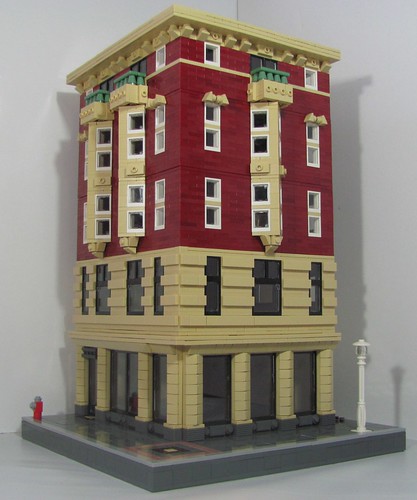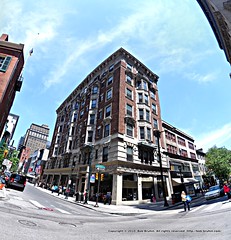
Nathaniel Brill has built one of those anonymous-urban buildings which all team up to create a downtown. But we're not here to talk about urban theory, dear reader. No, tonight's lecture is on Detail! In architecture parlance, details are all about connections, the condition when two differing materials meet. Details relates to LEGO on a whole number of levels (this is a hobby that is entirely about connecting pieces); tonight we discuss how Real World Detail (RD) translates to LEGO Detail (LD)
Nathaniel does a good job here, grabbing the right amount of RD to bring down to minifig scale. If you look at the super-high-rez source/reference pic, you'll see varying windows, some with decorative keystones, some with stone surrounds. He brings the keystones along, mixed with the entablatures to make a sort of LD pronounced keystone-thing. Those inwardly angled stone surrounds would be impossible to render without grossly oversizing the building. Also of note, the wrought-iron rails on the balconies are rather humorously bloated and squashed (just like a minifig!).
Well you've probably learned little-to-nothing, so let's cut to the Animaniacs-style Moral of the Story: when you are working on a LEGO model of a building/car/train/castle/spaceship, pay attention to how things are constructed in real life. This is the key difference between a MOC with walls of bricks and a MOC with brick walls.
Special note to spacers: greebles are not (necessarily) details. The way greebles are all-to-often used, they are more like ornamentation, a curse word as far as Modernity is concerned (pronounced Moe-dare-nitty for maximum pretension). As spaceships are generally Modern-ish in aesthetic (a debatable statement, perhaps worth a future posting!), this is decidedly out of place. It is the author's un-humble opinion that we could do with more details, less greebles.




One thing you never see in Lego is TOD.
ReplyDeletetime of death?
ReplyDeleteTransit-Oriented Development
ReplyDelete^ I'm on it, Leigh. It'll just be 30s TOD.
ReplyDeleteNice discussion of why most LEGO buildings are shit (my reading). I think what Nathaniel has done really well is compress the important details while not covering it in bristly spines like CC-style buildings. Although some street level detail wouldn't go astray.
Feel like having a go at context sometime? Because if there's one thing most LEGO builders fail miserably at it's that. Otherwise known as the "no most towns don't have a train line next to the city hall" effect.
Good thought Tim. I'll keep an eye out for MOCs that are conducive to a conversation on context.
ReplyDeleteAgreed re: street level details. I assume that because this is for a LUG display, some of that stuff will be added the day of the event. (this is how I recall moonbase working. maybe LUGs are more organized about it?)
"Special note to spacers: greebles are not details. The way greebles are all-to-often used, they are more like ornamentation, a curse word as far as Modernity is concerned. As spaceships are generally Modern-ish in aesthetic, this is decidedly out of place. It is the author's un-humble opinion that we could do with more details, less greebles."
ReplyDeleteSo I'm doing the stereotypical thing of building a SHIP. I have the parts and usually the patience that I think I can create one. But after reading this I realized this passage summed up a lot of what I'm building. But then I realized something else. My SHIP is supposed to be alien. So I have no idea what kind of details I should use. Any one have any ideas or comments to help out?
*fewer greebles
ReplyDelete